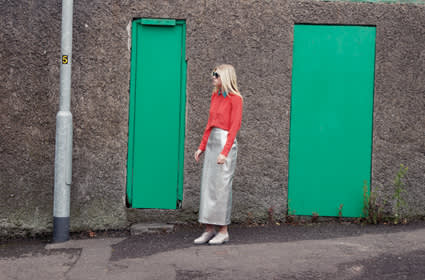 Preview: This story will appear in FADER #81, on stands in August. For more on JF & Son, check out FADER TV for a visit with them at their booth at the Capsule Tradeshow, where they were showing off Spring 2013 and their brand new menswear collection.
Preview: This story will appear in FADER #81, on stands in August. For more on JF & Son, check out FADER TV for a visit with them at their booth at the Capsule Tradeshow, where they were showing off Spring 2013 and their brand new menswear collection.
JF & Son cut cloth for everyone.
JF & Son designers Jesse Finkelstein and Katie King began shaping their fall collection around the uncomplicated form of a collared, button-down blouse, then “incorporating some of the beadwork that we do, some of the prints,” says Finkelstein. “Just looking at this very simple thing and thinking about how many ways you can play with that.” But while that basic silhouette anchors the line, it’s been riffed to sublimation with acidy, large-print florals, deep teals crowned with amber-beaded collars, sherbet color blocks, prints that ape hallucinatory sunsets and hemlines that hit at the hip or trail diaphanously down to the ankle. It’s as if the designers internalized the notion that a simple cylinder can contain a kaleidoscope, and then set about spinning their own rainbow within a similarly rigid form. “The classic silhouettes are good for our customer because we have such a range in age. A simple, more wearable piece but adding an interesting print or element to it really works for us,” says King. “Just making stuff—not necessarily ugly, but just sort of off, something that makes people stop and think about it.”
Since they launched their vertically-integrated brand and retail space, Finkelstein and King’s intention for JF & Son has always been to create a place in which they could interact directly with their ways and means of production: owning a store enables them to get feedback from their customers and see what sells best, which they can then respond to in their designs and communicate directly back to their 16-person studio outside of Shanghai that produces the clothing. Being close to both the customer and the production enables Finkelstein and King to be inextricably linked in the chain of consumption so that nothing gets lost in translation.
They’re also able to make their clothing more efficiently and therefore more affordably—so much so that they’re launching a diffusion line called JF 150, in which every piece of clothing will retail below $150, literally making good on their something-for-everyone ethos. This openness allows them the freedom to engage in one-off collaborations with visual artists, including pieces with K8 Hardy, Julia Sherman and Francesca DiMattio, among others, as well as to participate in an upcoming residency entitled “Epic Failure” at the Museum of Art and Design. “We don’t have total control over our brand image. We like to think our company is open,” says Finkelstein. “Things don’t feel so top down or dictatorial.” The fashion world could stand to elect more like-minded rulers.
Styling Mobolaji Dawodu.
